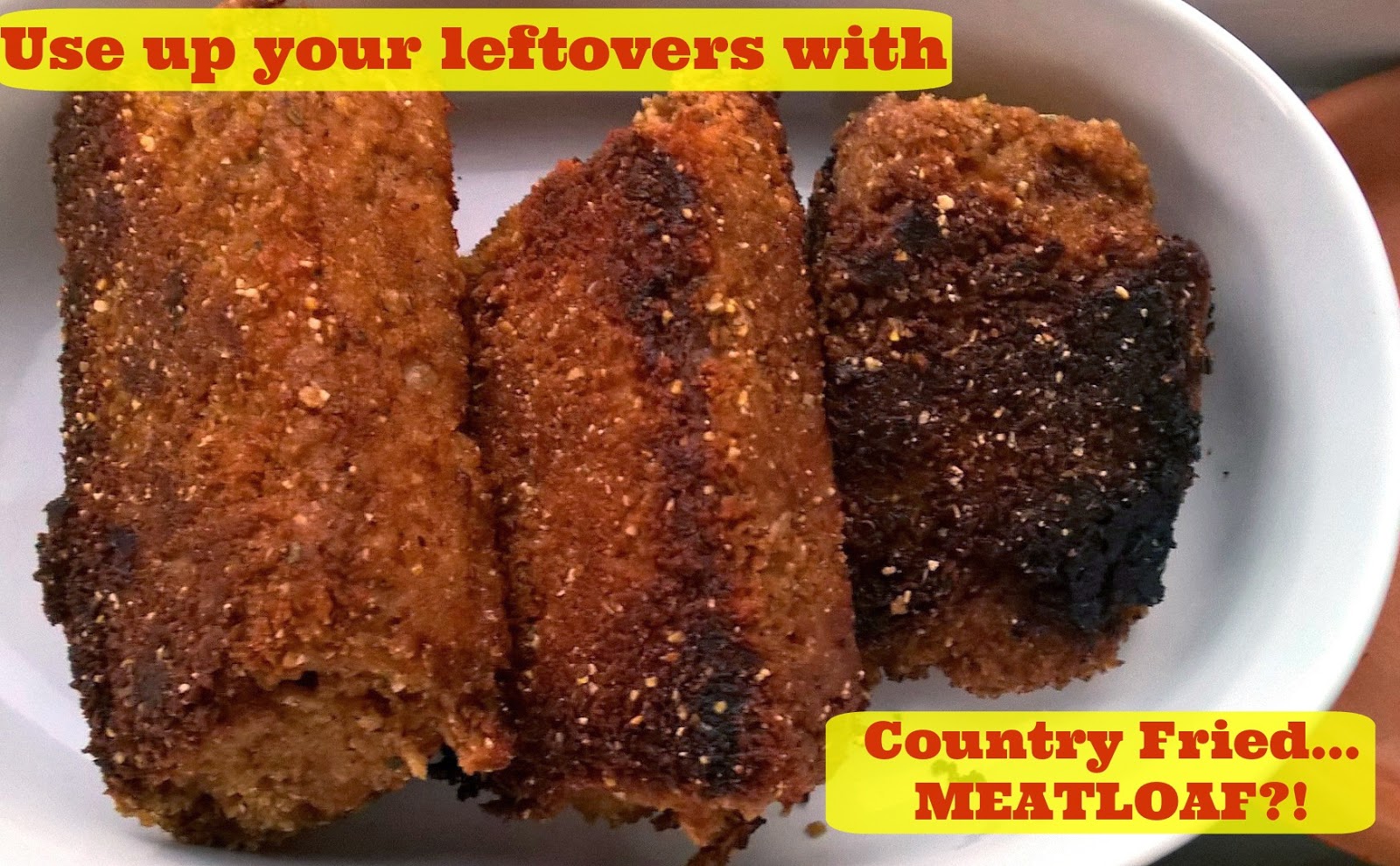I purposely made extra meatloaf so that I could try this recipe out, it sounded so delicious. It combines two of my favorites: meatloaf and fried breading.
The recipe should be useable for any meatloaf, as long as it holds its shape once chilled, so that it can be sliced and breaded. The recipe we use is my husband's, and it came from his Betty Crocker cookbook. He has modified it over the years, perfecting it for our family's tastes (the most important modification is the topping--ketchup, bbq sauce, and honey).
So, the next day, when your leftover meatloaf has chilled into a firm lump, you can slice it up, bread it, and fry according to the recipe. I served the meatloaf with a basic beef stock gravy, but I would imagine that a white country gravy would be just as tasty. It also would be delicious served on homemade buns for sandwiches. The recipe can be halved, double, tripled--whatever you need to do to get the right proportions for the amount of meatloaf you have leftover.
1 egg
1 tablespoon milk
1 cup breadcrumbs
1 tablespoon cornmeal
1/2 tablespoon flour
1/2 teaspoon salt
1/4 teaspoon onion powder
1/4 teaspoon Italian seasoning
pinch of paprika
pinch of garlic powder
6 slices thoroughly chilled meatloaf
4 tablespoons fat or oil for frying (I used a butter/lard combo)
1. In a pie pan or other wide, shallow dish, combine the milk and egg, beating well to combine.
2. In another pie pan, add the breadcrumbs, cornmeal, flour, salt, onion powder, Italian seasoning, paprika, and garlic powder. Using a fork, combine ingredients well.
3. Dip each slice of meatloaf into the egg/milk mixture, and then into the breadcrumb mixture, turning and pressing the crumbs into the meatloaf to coat it well. Lightly shake off the slice, and place it on a platter. Continue in the same manner for the remaining slices.
4. Once all slices have been breaded, heat the fat in a large, heavy skillet over medium high heat. Once hot, add the breaded meatloaf slices to the skillet. Fry for 3-4 minutes or until golden brown, then turn and fry on the other side until golden brown. Adjust heat if necessary to avoid burning.
5. Keep slices warm in the oven while you prepare the gravy:
6. Serve meatloaf slices with gravy.
The recipe should be useable for any meatloaf, as long as it holds its shape once chilled, so that it can be sliced and breaded. The recipe we use is my husband's, and it came from his Betty Crocker cookbook. He has modified it over the years, perfecting it for our family's tastes (the most important modification is the topping--ketchup, bbq sauce, and honey).
So, the next day, when your leftover meatloaf has chilled into a firm lump, you can slice it up, bread it, and fry according to the recipe. I served the meatloaf with a basic beef stock gravy, but I would imagine that a white country gravy would be just as tasty. It also would be delicious served on homemade buns for sandwiches. The recipe can be halved, double, tripled--whatever you need to do to get the right proportions for the amount of meatloaf you have leftover.
Country Fried Meatloaf
1 egg
1 tablespoon milk
1 cup breadcrumbs
1 tablespoon cornmeal
1/2 tablespoon flour
1/2 teaspoon salt
1/4 teaspoon onion powder
1/4 teaspoon Italian seasoning
pinch of paprika
pinch of garlic powder
6 slices thoroughly chilled meatloaf
4 tablespoons fat or oil for frying (I used a butter/lard combo)
1. In a pie pan or other wide, shallow dish, combine the milk and egg, beating well to combine.
2. In another pie pan, add the breadcrumbs, cornmeal, flour, salt, onion powder, Italian seasoning, paprika, and garlic powder. Using a fork, combine ingredients well.
3. Dip each slice of meatloaf into the egg/milk mixture, and then into the breadcrumb mixture, turning and pressing the crumbs into the meatloaf to coat it well. Lightly shake off the slice, and place it on a platter. Continue in the same manner for the remaining slices.
4. Once all slices have been breaded, heat the fat in a large, heavy skillet over medium high heat. Once hot, add the breaded meatloaf slices to the skillet. Fry for 3-4 minutes or until golden brown, then turn and fry on the other side until golden brown. Adjust heat if necessary to avoid burning.
5. Keep slices warm in the oven while you prepare the gravy:
If necessary, add more fat to the hot pan. You will want about 1 tablespoon of fat in the pan. Whisk in 1 tablespoon of flour. Cook until a bubbly, soft paste has formed. Slowly add 1 cup beef broth, whisking constantly. Cook, whisking constantly, until gravy is thick and bubbly.
6. Serve meatloaf slices with gravy.

Comments
Post a Comment
I will just take a quick peek at your comment before it posts to avoid getting bombarded by spam. Please don't take it personally, I'm sure you're a lovely person.